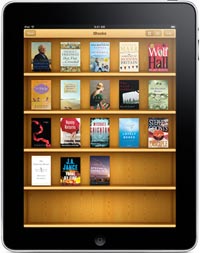
E-Book Apps: You’re Doing It Wrong
Publishers are looking to create stand-alone e-book applications for the iPad. Rather than simply creating an ePub-formatted text to be purchased, stored, and read in the iBooks app, the idea here is to go ignore the ePub standard in order to bundle extras with the book. They’d provide you with an individual computer program to be installed and run just to read a single book. In the case of Penguin Books:
We will be embedding audio, video and streaming in to everything we do. The .epub format, which is the standard for ebooks at the present, is designed to support traditional narrative text, but not this cool stuff that we’re now talking about. […] So for the time being at least we’ll be creating a lot of our content as applications, for sale on app stores and HTML, rather than in ebooks.
The enhanced Baldacci e-book is one of several projects Hachette will release over the coming weeks, including a NASCAR-oriented app, a synchronized text/audio edition of Michael Connelly’s crime novel Echo Park, and a standalone app version of David Foster Wallace’s thousand-page magnum opus Infinite Jest. “One reason the book is so famous is because of the footnotes,” says Maja Thomas, senior VP of Hachette Digital. “We thought, wouldn’t it be great if, when a footnote appears, there’s a symbol in the e-version of the text, and if you tap on it, you can go right to the footnote, and then tap back into the text at any time.”
Even Random House is pushing these stand-alone apps as a class of books, which they call Book and Beyond.
All of this is both a bad idea on many levels and largely unnecessary.

What about in a couple of years, when Microsoft or Sony or Amazon releases a whizzy new e-book reader that you want to upgrade to after your iPad gives up the ghost? You can take your ePub files with you to that new reader … but your iPad-only, collectors-edition Infinite Jest application won’t run on your new device. You’ll have to buy those books again to read them.
From the perspective of consumers, it’s tough to envision how stand-alone e-book applications are better than simply reading an e-book in your e-book software.
The situation isn’t much better for publishers. Creating an ePub file isn’t particularly challenging (it’s basically a website, each chapter its own web page), with your average novel requiring maybe a few days’ work for a website developer of average ability. Creating one or more stand-alone e-book applications—one for each popular e-reader—for every book? As we programmers say, that’s nontrivial: expensive, time-consuming, and prone to bugs, requiring an approval process from some manufacturers (including Apple—which can be capricious), meaning that there’s always the possibility that all that work could be for nothing. It is an order of magnitude more complex to developing an application rather than an ePub file.
Most of the extras that Penguin intends to bundle with their books can be included with an ePub. Excised passages and research photos can be included as additional chapters, and video and audio can even be embedded by a moderately clever developer. (Hatchette’s vision of DFW-style footnotes can be realized with even the crudest of e-books.) The very modest benefits of a stand-alone application are overwhelmed by the drawbacks. Any shortcomings in the ePub standard are cause for publishers to bring their considerable resources to bear in improving that standard, rather than simply bailing on it. Eschewing stand-alone e-book applications for ePubs will save money for publishers and, more important, make customers much happier in both the short and the long run.
